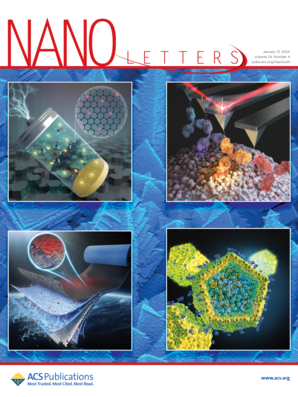Unraveling Oxyanion Effects on Oxygen Evolution Electrocatalysis of Nickel Hydr(oxy)oxides: The Critical Role of Fe Impurities
IF 9.6
1区 材料科学
Q1 CHEMISTRY, MULTIDISCIPLINARY
引用次数: 0
Abstract
Electrolyte modulation can enhance the performance of electrocatalysts for the oxygen evolution reaction (OER) by tailoring the electrocatalyst-electrolyte interface, but the role of anion additives remains controversial. Herein, we report our findings on unraveling the effects of oxyanions (NO3–, SO42–, and PO43–) and identifying Fe impurities as the key factor driving OER activity enhancement in Ni hydr(oxy)oxide model catalysts. Fe impurities, introduced via oxyanion salts, significantly enhance OER activity, while oxyanions themselves have minimal direct impact when Fe ions are removed. Our results, including operando Raman spectroscopy, reveal that Fe enhances Ni reducibility/redox reversibility. X-ray absorption spectroscopy and density functional theory calculations indicate that Fe preferentially adsorbs on Ni surface sites with higher deprotonation energy. These findings reveal the critical role of surface-adsorbed Fe in modulating Ni hydr(oxy)oxide activity and highlight overlooked impurity effects in electrocatalysis when studying additive effects in electrolyte modulation.

揭示氧离子对镍氢(氧)氧化物析氧电催化的影响:铁杂质的关键作用
电解质调制可以通过调整电催化剂-电解质界面来提高析氧反应(OER)电催化剂的性能,但阴离子添加剂的作用仍然存在争议。在此,我们报告了我们的发现,揭示了氧离子(NO3 -, SO42 -和PO43 -)的影响,并确定了铁杂质是驱动Ni氢(氧)氧化物模型催化剂OER活性增强的关键因素。通过氧阴离子盐引入的铁杂质显著提高了OER活性,而氧阴离子本身在去除铁离子时对OER活性的直接影响最小。我们的结果,包括操作拉曼光谱,揭示了铁增强镍的还原性/氧化还原可逆性。x射线吸收光谱和密度泛函理论计算表明,Fe优先吸附在脱质子能较高的Ni表面。这些发现揭示了表面吸附铁在调节Ni氢(氧)氧化物活性中的关键作用,并突出了在研究电解质调制中的添加剂效应时电催化中被忽视的杂质效应。
本文章由计算机程序翻译,如有差异,请以英文原文为准。
求助全文
约1分钟内获得全文
求助全文
来源期刊

Nano Letters
工程技术-材料科学:综合
CiteScore
16.80
自引率
2.80%
发文量
1182
审稿时长
1.4 months
期刊介绍:
Nano Letters serves as a dynamic platform for promptly disseminating original results in fundamental, applied, and emerging research across all facets of nanoscience and nanotechnology. A pivotal criterion for inclusion within Nano Letters is the convergence of at least two different areas or disciplines, ensuring a rich interdisciplinary scope. The journal is dedicated to fostering exploration in diverse areas, including:
- Experimental and theoretical findings on physical, chemical, and biological phenomena at the nanoscale
- Synthesis, characterization, and processing of organic, inorganic, polymer, and hybrid nanomaterials through physical, chemical, and biological methodologies
- Modeling and simulation of synthetic, assembly, and interaction processes
- Realization of integrated nanostructures and nano-engineered devices exhibiting advanced performance
- Applications of nanoscale materials in living and environmental systems
Nano Letters is committed to advancing and showcasing groundbreaking research that intersects various domains, fostering innovation and collaboration in the ever-evolving field of nanoscience and nanotechnology.
 求助内容:
求助内容: 应助结果提醒方式:
应助结果提醒方式:


